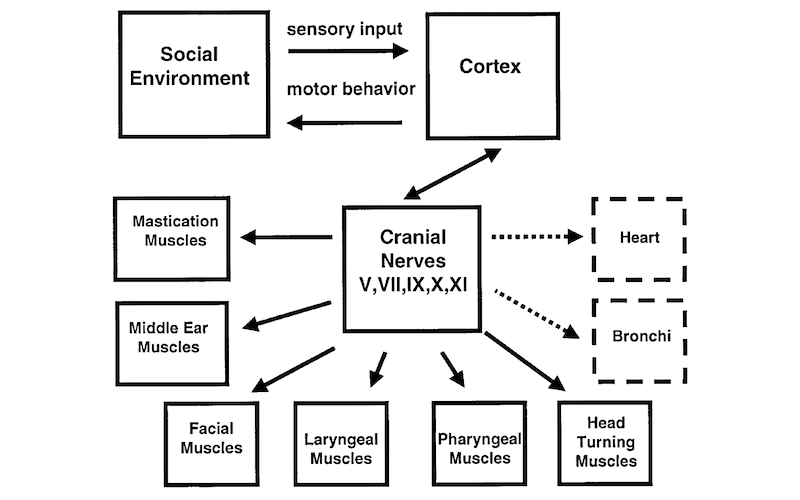
The vagus network is an integral part of the autonomic nervous system. It innervates the heart, lungs, vast tracks of the gastrointestinal system and is critical to the overall regulation of parasympathetic function and homeostasis.
Polyvagal theory expands on our understanding of the vagus network. Polyvagal Theory brings to light connections between breathing, heart rate, the overall state of the body, the subconscious assessment of threat and neurological regulation of social engagement.
Polyvagal theory reflects recent neuroanatomical insights and novel evolutionary shifts of the mammalian nervous system. These changes within the mammalian nervous system has created two distinct vagal networks – hence the term polyvagal. Each of these networks has radically different adaptive roles and connections within the mammalian nervous system.
One network is old (from an evolutionary perspective) and slow. It is transmitted via unmyelinated nerves to primitive limbic structures and the sympathetic nervous system. This old vagus system, in conjunction with the sympathetic nervous system, regulates flight, fright and immobilisation behaviours.
The other vagus, which is evolutionarily newer, is transmitted via myelinated nerves which enable the rapid regulation of our cardiovascular system (heart rate and blood pressure). This newer branch of the polyvagal system is extensively interconnected with cranial nerves and higher brain structures which influence social engagement.

The social engagement system consists of several interconnected neural pathways. These neural pathways originate from different cranial nerves, including the bright shiny fast vagus. The social engagement system couples the modulation of heart rate and overall bodily state to the muscles of the face and head – this is called the heart-face connection. These muscles collectively enable social engagement through emotional expression, eyelid opening, chewing, extraction of the human voice from background noise, vocalisation, intonation and head orientation. This neurobiological connection and integration of bodily state and social engagement regulates other systems including the hypothalamic pituitary adrenal axis (hormonal stress response system) and immune systems.
Polyvagal Theory presents a pattern of influence in which social behaviour influences the internal state of the body and the internal state of the body influences social behaviour.
Polyvagal Theory research employs the measurement of respiratory sinus arrhythmia (RSA) – a naturally occurring variability in heart rate which is closely linked to breathing. RSA is used as an indirect measurement of the function of the new vagus and the integrity of the social engagement system.
Studies have shown that high RSA is linked to reduced psychopathology and delinquency, as well as greater emotional expressivity, emotional resilience and enhanced stress regulation. By contrast low RSA has been identified in children that have been subjected to restrictive parenting practices. In adults, poor modulation of RSA has been associated with greater social anxiety. Improved RSA has been shown to parallel positive treatment outcomes in patients with depression. Low RSA has been found to covary with low muscle tone in the upper face – potentially impacting on facial expression and social engagement. Polyvagal theory is being employed to identify some of the physiological signatures which accompany specific psychiatric profiles.
FEATURED IMAGE:
S.W. Porges. The polyvagal theory: phylogenetic substrates of a social nervous system (2001).
